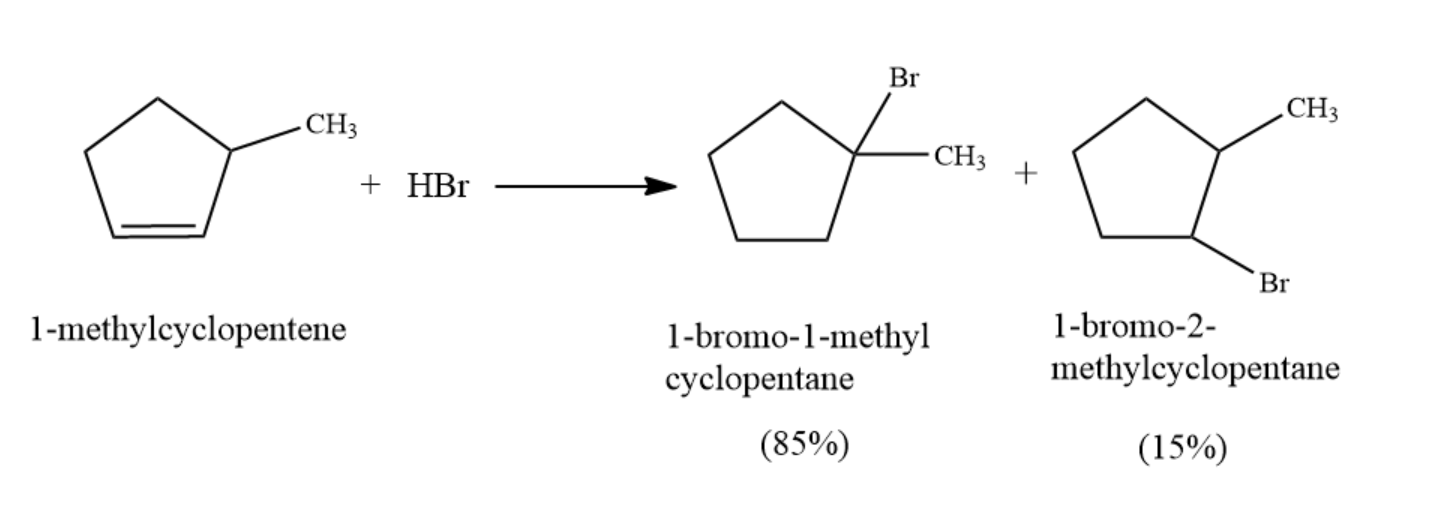
What are the major products formed in the following reaction?


Answer
429k+ views
Hint: In the above reaction
Complete answer:
In the above reaction, we see that
The product formed in the above reaction is as follows:

So it can be seen that the major product in the following reaction is
The reaction taking place here between
In addition to reaction, any halogen can be used except fluoride. In these reactions, asymmetrical carbons are treated with HX (where X is any halogen bromine, chlorine, or iodine) and this results in the formation of a product that is alkyl halide. The reaction occurs via Markonikoff’s rule. According to the rule when a protic (HX) is added to an asymmetric alkene, the acidic hydrogen attaches itself to the carbon having a greater number of hydrogen substituents whereas the halide group attaches itself to the carbon atom which has a greater number of alkyl substituents.
Note:
In such a reaction whenever there is the use of peroxide then the reaction occurs via anti-markovnikov's rule. This is exactly the opposite of that of Markonikoff’s rule. The reactions that occur via anti-markovnikov's rule are called free radical addition reactions.
Complete answer:
In the above reaction, we see that
The product formed in the above reaction is as follows:

So it can be seen that the major product in the following reaction is
The reaction taking place here between
In addition to reaction, any halogen can be used except fluoride. In these reactions, asymmetrical carbons are treated with HX (where X is any halogen bromine, chlorine, or iodine) and this results in the formation of a product that is alkyl halide. The reaction occurs via Markonikoff’s rule. According to the rule when a protic (HX) is added to an asymmetric alkene, the acidic hydrogen attaches itself to the carbon having a greater number of hydrogen substituents whereas the halide group attaches itself to the carbon atom which has a greater number of alkyl substituents.
Note:
In such a reaction whenever there is the use of peroxide then the reaction occurs via anti-markovnikov's rule. This is exactly the opposite of that of Markonikoff’s rule. The reactions that occur via anti-markovnikov's rule are called free radical addition reactions.
Latest Vedantu courses for you
Grade 8 | CBSE | SCHOOL | English
Vedantu 8 CBSE Pro Course - (2025-26)
School Full course for CBSE students
₹45,300 per year
Recently Updated Pages
Master Class 11 Business Studies: Engaging Questions & Answers for Success

Master Class 11 Economics: Engaging Questions & Answers for Success

Master Class 11 Accountancy: Engaging Questions & Answers for Success

Master Class 11 Computer Science: Engaging Questions & Answers for Success

Master Class 11 English: Engaging Questions & Answers for Success

Master Class 11 Maths: Engaging Questions & Answers for Success

Trending doubts
Which one is a true fish A Jellyfish B Starfish C Dogfish class 11 biology CBSE

Difference Between Prokaryotic Cells and Eukaryotic Cells

1 ton equals to A 100 kg B 1000 kg C 10 kg D 10000 class 11 physics CBSE

1 Quintal is equal to a 110 kg b 10 kg c 100kg d 1000 class 11 physics CBSE

One Metric ton is equal to kg A 10000 B 1000 C 100 class 11 physics CBSE

How much is 23 kg in pounds class 11 chemistry CBSE




